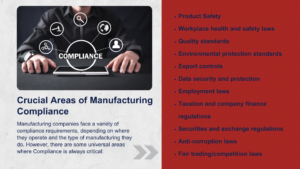Manufacturing Compliance Management 101

The margin for error in manufacturing compliance is razor-thin, as demonstrated by the infamous Abbott Laboratories case. The company was fined $100 million by the U.S. Food and Drug Administration (FDA) for failing to comply with updated medical device manufacturing regulations. The FDA’s investigation uncovered serious lapses in quality control, leading to the distribution of devices that did not meet safety standards. This high-profile incident highlights the financial and legal risks and the potential consequences for public health and a company’s reputation.
This real-life scenario serves as a critical reminder that Compliance in manufacturing isn’t just another item on the to-do list. It’s an ongoing challenge that demands unwavering attention. The path to Compliance can often feel like a moving target, where even a single oversight can lead to severe financial penalties, legal action, and long-lasting damage to a company’s reputation.
Think about it:
- What hidden risks might be embedded within your processes, quietly threatening compliance efforts?
- How can you ensure your team stays ahead, fully equipped with the necessary knowledge and training?
- What strategies can you use, as regulations constantly shift, to keep your policies watertight?
- And when it comes to your third-party vendors, how confident are you that they meet the latest standards?
These questions highlight the complexities of manufacturing compliance. To address these pressing concerns, we first need to understand what Compliance in manufacturing truly entails. So, let’s dive in!
What Is Compliance in Manufacturing?
Compliance in manufacturing is much more than simply adhering to rules. It is about ensuring every aspect of your operation aligns with a complex network of regulations and internal standards crucial for success. But what does this really involve?
Every manufacturer needs to be aware of two key types of compliance: Regulatory and Corporate Compliance.
- Regulatory Compliance involves following the laws and regulations set by governments and industry bodies, which vary depending on your industry, location, and specific business operations. This is where regulatory Compliance in manufacturing plays a crucial role, ensuring that your processes meet the legal standards required to avoid fines and penalties.
- Corporate Compliance goes a step further, covering your internal policies and procedures to ensure your company operates within external regulations and your established internal standards.
For global manufacturers, Compliance isn’t just about knowing the rules. It’s about understanding the specific regulatory environments in your region. What’s considered a standard safety procedure in the U.S. might not meet the requirements in your facilities in China. Mastering these regional differences is essential for maintaining Compliance across all your operations.

Top Regulations and Standards in Manufacturing
Successfully managing Compliance in manufacturing requires a deep understanding of several critical regulations and standards. These guidelines are crucial for ensuring product safety, operational efficiency, and legal Compliance. Below are some of the key regulations and standards that manufacturers must keep in mind:
- ISO 9001: The globally recognized standard for quality management systems, ensuring consistent product quality.
- ISO 14001: Focuses on environmental management systems, helping companies minimize their environmental impact.
- OSHA (Occupational Safety and Health Administration): U.S. regulations designed to ensure safe and healthy working conditions.
- Good Manufacturing Practice (GMP) is the essential standard for production and quality control in the pharmaceutical and food industries.
- LEAN Manufacturing: A methodology aimed at improving efficiency by eliminating waste in production processes.
- Six Sigma: A process improvement strategy focused on reducing defects and enhancing quality.
- HACCP (Hazard Analysis and Critical Control Points): This system is designed to identify and control potential hazards in food safety management.
- NFPA (National Fire Protection Association): Standards to prevent fire and explosion hazards in manufacturing environments.
- CE Marking: Indicates that a product meets European safety, health, and environmental protection standards.
- AS9100: A quality management system specifically tailored for the aerospace industry, incorporating ISO 9001 with additional aerospace-specific requirements.
Staying updated on these standards is not just about Compliance—it’s about maintaining the integrity of your operations and ensuring that your manufacturing processes meet the highest levels of safety and quality. Implementing GRC solutions for manufacturing can be invaluable in keeping track of these standards and ensuring continuous Compliance.
Key Steps to Achieve Compliance in Manufacturing Industries
Achieving Compliance is an ongoing process that requires careful planning and execution. To tackle the hidden risks and shifting regulations, here are eight essential steps to help manufactures get there:
- Conduct a Comprehensive Compliance Risk Assessment: Start by thoroughly assessing the potential risks in your industry, internal policies, and external standards. This helps you understand the specific compliance landscape for your manufacturing operations and addresses the hidden risks that may threaten your efforts.
Pro Tip: Utilize manufacturing audit tools with built-in risk assessment modules to streamline this process. These tools often come with templates and industry-specific checklists that can make your assessment more accurate and less time-consuming.
- Establish Clear Compliance Objectives and Policies: Define clear, measurable objectives that align with your company’s values and industry standards. Develop robust policies that guide employees and ensure they are well-communicated throughout the organization, helping you stay ahead with well-equipped teams.
Pro Tip: Use GRC platforms that offer centralized policy management modules, enabling you to track, update, and distribute policies seamlessly.
- Implement Robust Documentation Practices: Keep detailed records of your processes, procedures, and compliance activities. Proper documentation is key to transparency and will be crucial during audits or assessments, especially as regulations continue to evolve.
Pro Tip: Leverage GRC software to automate documentation processes. These tools often feature audit trails and automated reporting, which help maintain up-to-date and organized records without the manual hassle.
- Implement Regular Compliance Training: Ensure your workforce has the necessary knowledge and skills. Regular training should cover relevant regulations, internal policies, and updates to compliance requirements, ensuring that your team is always prepared.
Pro Tip: Ensure consistent training to your employees. Track their progress, schedule automated reminders for retraining, and provide interactive learning experiences tailored to your industry.
- Monitor and Audit Compliance Practices: Establish a system to regularly review and audit compliance practices. This allows you to identify potential issues early and make necessary adjustments, keeping your policies watertight.
Pro Tip: GRC tools often include monitoring and auditing modules that provide real-time insights and automated alerts when potential compliance breaches are detected, allowing you to respond proactively.
- Establish a Reporting and Communication System: Create clear channels for reporting compliance issues. Encourage open communication within the organization to address concerns promptly and ensure that employees can report issues without fear, especially when working with third-party vendors.
Pro Tip: GRC platforms often come equipped with incident reporting and communication tools that ensure compliance issues are reported, tracked, and resolved in a secure and confidential manner.
- Respond Promptly to Non-Compliance Issues: When issues arise, act quickly to address them. Investigate the root causes, implement corrective actions, and communicate transparently with stakeholders, ensuring your operations remain on track.
Pro Tip: Use the incident management modules within your GRC tool to document non-compliance issues, assign tasks, and track the resolution process, ensuring a timely and effective response.
- Continuously Improve Compliance Processes: Regularly evaluate and enhance your compliance processes. Stay informed about industry developments, regulatory changes, and best practices to keep your company agile and adaptive, supporting long-term success.
Pro Tip: GRC tools often offer analytics and reporting features that can help you identify trends, measure the effectiveness of your compliance efforts, and make data-driven decisions to continuously improve your processes.
Conclusion
Compliance in manufacturing is tough. Just one slip, and it can all come crashing down. As Warren Buffett said, “It takes 20 years to build a reputation and five minutes to ruin it.” That’s why staying ahead of regulations is so important.
At iTech GRC, we streamline risk and compliance management with IBM OpenPages, a leading governance, risk, and compliance (GRC) platform. Designed specifically for manufacturers, our solution automates risk management, ensures regulatory compliance, and enhances decision-making through integrated data and advanced analytics. With IBM OpenPages, you can efficiently manage compliance checklists for all relevant laws, receive real-time legal updates, and monitor all GRC processes through a cloud-based dashboard. Automated alerts and reminders keep you on track, ensuring you never miss a compliance deadline. Additionally, our platform provides detailed compliance performance reports across all your locations and offers a centralized document repository with advanced search and expiry alert features, making document management seamless and efficient.
How do you handle compliance challenges? We’d love to hear your thoughts; drop a comment below!
